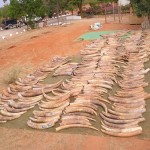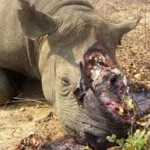 The last 365 days have proved to be one of the worst years for poaching since the 1980s. In 2012, it is estimated that over 17,000 elephants and 700 rhino were lost during this ongoing global war against wildlife poaching. Keep in mind these are but two out of hundreds of species that were affected. The last year has been filled with both triumphs and failures as conservationists fight to conserve these magnificent creatures. Unfortunately, as we are only 14 days into a new year, the killing continues. Already reports out of Kenya reports an entire African elephant family has been slaughtered. Within this same time, officials in Mombasa and Hong Kong confiscated over 2 tons of ivory worth $3 million US. With blood being spilt at an alarming rate, one begs to ask if these atrocities can ever be stopped?
The last 365 days have proved to be one of the worst years for poaching since the 1980s. In 2012, it is estimated that over 17,000 elephants and 700 rhino were lost during this ongoing global war against wildlife poaching. Keep in mind these are but two out of hundreds of species that were affected. The last year has been filled with both triumphs and failures as conservationists fight to conserve these magnificent creatures. Unfortunately, as we are only 14 days into a new year, the killing continues. Already reports out of Kenya reports an entire African elephant family has been slaughtered. Within this same time, officials in Mombasa and Hong Kong confiscated over 2 tons of ivory worth $3 million US. With blood being spilt at an alarming rate, one begs to ask if these atrocities can ever be stopped?
Awareness campaigns by wildlife conservation organizations have been around for decades. Through social media sites, grassroots efforts, seminars, webinars, conferences, mailers, etc., groups like World Wildlife Fund (WWF), International Fund for Animal Welfare (IFAW), and Nature Conservancy, just to name a few, have been reaching out to the general public to generate support for animal conservation and habitat preservation. As a result, people join these groups subsequently raising funds through memberships or simple donations. Generated dollars are then sent to research wildlife in high conflict zones and monitor poaching. But is this plan working? Awareness campaigns are expensive. Is this money well spent or money not spent well? Furthermore, It is no surprise that the face of the poacher is changing, as well as those charged with purchasing wildlife products. So, are awareness campaigns really targeting those individuals whose consumption, or lack thereof, makes a difference? A popular movement in Hong Kong against shark-fin soup has been instrumental in building an understanding and support. The majority of the public was not aware of the consequences of such a product and when they did made a change. If China is the number one consumer of ivory and rhino horn, are awareness campaigns effectively targeting the Chinese people?
An increase in poacher numbers in range countries in Africa has resulted in an increase in ranger numbers to patrol wildlife areas. Both sides are losing men, and wildlife is still dying. Is fighting fire with fire really working? Only in areas lucky enough to be guarded 24 hours a day 7 days a week by armed guards is poachers deterred. Long-term, this plan is not feasible, but currently it is all we have to protect precious species on the brink of extinction.
Poaching is a global problem and therefore requires a global solution. Simple acknowledgment of the problem and a pledge to help from world superpowers like the United States, United Kingdom, and Russia will inevitably pave the road for success. By working together, these countries could set the standard by which all others use as a model. However, in doing so, things will have to change within their own borders as well. We cannot fail our native wildlife by allowing poaching to occur unchecked or poorly manage native flora and fauna, nor can we allow wildlife protection to fall through the cracks due to poor legislation or a preset agenda by large companies hungry for natural resources. With the fight on drugs and weapons still unable to be controlled internationally, how can we expect anything different with governing the illegal wildlife trade?
There has been an argument slowly growing concerning the lack of support and the effects of poor decision making on the part of influential governing organizations like the International Union for Conservation of Nature (IUCN) and Convention on International Trade in Endangered Species of Wild Flora and Fauna (CITIES). Prior to 2004, African elephants were listed as an endangered species; a status which gave this species top priority for protection and conservation efforts. However, in 2004, the African elephant was delisted from endangered to vulnerable. Is it merely a coincidence that the following year poaching increased rapidly? Could this move by the IUCN and CITIES contributed to the level of killing we observe today? In addition, one-off sales of stock piled ivory in a few African countries were approved by these same organizations, despite pleas against such a transaction from elephant conservationist and researchers.
 So what is the answer? Where do we go from here? Worldwide compliance and participation is needed to conserve wildlife and wild areas; that is the bottom line. Getting the public aware of poaching and the result of such heinous acts is absolutely a top priority; people only care about what they love. But how do we take such awareness to the next level, which is ultimately to save lives? Only when we stop the demand will we stop the killing. Targeting the consumers is the next logical step. Educate those individuals who view ivory and rhino horn, pangolin scales and tiger bone, bear bile and leopard fur as either a medicinal remedy or status symbol: change their minds. As a society we must demand accountability for those individuals or organizations that continue to perpetuate the illegal killing of wildlife for their parts regardless of government or religious affiliations. Now is not the time to talk in vagueness, but to speak up for what needs to be done to ensure wildlife never suffers another year like the last. Let us look back on 2012 as a turning point on the war against poaching as the time when wildlife advocates started to win and wildlife started to once again thrive.
So what is the answer? Where do we go from here? Worldwide compliance and participation is needed to conserve wildlife and wild areas; that is the bottom line. Getting the public aware of poaching and the result of such heinous acts is absolutely a top priority; people only care about what they love. But how do we take such awareness to the next level, which is ultimately to save lives? Only when we stop the demand will we stop the killing. Targeting the consumers is the next logical step. Educate those individuals who view ivory and rhino horn, pangolin scales and tiger bone, bear bile and leopard fur as either a medicinal remedy or status symbol: change their minds. As a society we must demand accountability for those individuals or organizations that continue to perpetuate the illegal killing of wildlife for their parts regardless of government or religious affiliations. Now is not the time to talk in vagueness, but to speak up for what needs to be done to ensure wildlife never suffers another year like the last. Let us look back on 2012 as a turning point on the war against poaching as the time when wildlife advocates started to win and wildlife started to once again thrive.
